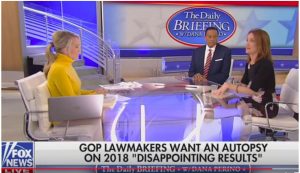2018 Fourth Quarter in Review
Trump Adopts Our Ideas for Obamacare Reform

FORMER SEN. RICK SANTORUM AND JOHN GOODMAN DISCUSS HEALTH REFORM AT THE HERITAGE FOUNDATION BUILDING IN WASHINGTON D.C.
In a big win for the Goodman Institute, the administration is wholly or partially implementing 5 bold ideas that were in the Sessions/Cassidy health reform bill.
- Personal and portable health insurance: For the first time under Obamacare, employers will be able to buy employee-owned health insurance with pre-tax dollars.
- Tax fairness: Average-income employees will get the same tax break for individual insurance that they get for group insurance.
- Flexible health savings: Unlike the rigid restrictions that make Health Savings Accounts incompatible with most exchange plans, employees will have an account that wraps around any third party insurance – paying for medical expenses insurance doesn’t pay for.
- Limited benefit insurance: For the first time, employees who cannot afford Obamacare’s mandated insurance will be able to use a special, employer-funded savings account to buy health care directly as well as short-term insurance, which is not subject to Obamacare regulations.
- Health status insurance: Short-term insurance will be renewable for up to three years and a type of bridge insurance will allow people access to successive three-year periods (without penalty for a change in health condition) indefinitely into the future.
Under Obama, employers who purchased individually owned health insurance for their employees could be fined as much as $100 per employee per day, or $36,500 per employee per year – the largest fine in all of Obamacare for anybody who did anything.
Clearly the administration believes it can radically reform Obamacare without any act of Congress.
Trump Endorses Our Vision of Health Reform
The Trump administration has produced an astonishingly bold document: Reforming America’s Healthcare System Through Choice and Competition. This is the first time any administration has explicitly acknowledged that the most serious problems in health care arise not because of market failure, but because of unwise government policies. It is also the first time the federal government has committed itself to the idea of liberating the medical marketplace. In many ways the document is very similar to ideas John Goodman first proposed in Regulation of Medical Care: Is the Price Too High? (Cato) almost four decades ago.
Have you ever wondered why you can’t talk to your doctor by phone or by email? Or why you can’t be examined in your own home using a telephone app? Or why specialists at our top hospitals aren’t using telemedicine for long distance examinations of patients all over the country? Or why it’s so hard to use ordinary health insurance to contract with a concierge doctor?
In each of these cases normal market processes have been suppressed by unwise government regulation.
What Caused the Great Recession?
Goodman Institute Senior Fellow Laurence Kotlikoff has produced a very surprising and very readable account (no math; no equations) explaining the Great Recession. Turns out, all the standard explanations are wrong.
- Subprime loans never exceeded 14 percent of outstanding mortgages.
- At its peak, the subprime foreclosure rate was only 15%.
- Further, the recession itself caused mortgage defaults, not the other way around.
So what’s the answer? Credit market institutions should be required to have 100% reserves (an idea Milton Friedman proposed years ago). They would serve as pure intermediaries – connecting borrowers and lenders. Everyone else in the economy would be free to take unlimited risks. But credit market institutions would not be allowed to take any risk.
Kotlikoff calls this reform “limited purpose banking.” He and John Goodman wrote about it in The New Republic in 2009. He produced a whole book on the subject the following year.
CBO Takes a Closer Look at Kotlikoff’s Model
In December, the Congressional Budget Office convened a group of economists who work with about half a dozen macroeconomic models – thought to be the very best. All but one of these are closed economy models, however. That means they assume that government policies do not affect the flow of capital across our borders.
The exception is a model designed by Laurence Kotlikoff and his colleagues, with partial funding from the Goodman Institute. This model took three years to develop, has 3 ½ million equations and includes all the major economic regions of the world. A single run takes several computers operating 6 hours or more.
Kotlikoff’s model produces the strongest known defense of tax reform, and the results have been used by the White House Council of Economic Advisors to defend tax reform.
House GOP Adopts our Resolution
Leading into the election, Republican candidates were being hammered on “pre-existing conditions.” In response Rep. Pete Sessions (R-TX), Rep. Mark Meadows and about two dozen other House Republicans introduced a resolution crafted by the Goodman Institute.
Under the resolution House members made this commitment: States may ask for and receive broad authority to reform their individual health insurance markets, provided that people with pre-existing conditions are protected.
Protection for people with health conditions means: Lower premiums, lower out-of-pocket costs and wider networks than would otherwise have existed plus progress toward the ultimate goal of insuring that people who have been paying premiums to group plans and become too sick to work have access to individual insurance that is similar to group insurance in price, quality and access to care – regardless of health condition.
Revenue neutrality means: the expected long-term cost to the federal government cannot increase.

GOODMAN INSTITUTE BOARD MEMBER NAN HAYWORTH TELLS DANA PERINO AND JUAN WILLIAMS ” WE NEED TO BOLDLY INVEST IN … OUTREACH TO WOMEN.”
Outreach
Conservative writers are increasingly relying on the Goodman institute in discussing tax reform. Conservative talk show hosts reliably point to the Goodman Institute when discussing health reform. And former member of Congress and Goodman Institute board member Nan Hayworth is a regular guest on Fox News. John Goodman appears regularly on the speaker’s circuit.
A State-Based Revolution
This is one of the most under-reported and under-appreciated developments in modern public policy.
Former leaders of state-based think tanks include Vice President Mike Pence (Indiana), Gov. Charlie Baker (Massachusetts), Sen. Jeff Flake (Arizona), Rep. Gary Palmer (Alabama) and Presidential Advisor Brooke Rollins (Texas). These organizations are the source of such national public policy victories as criminal justice reform (Texas), the right-to-try law, giving terminally ill patients access to potentially lifesaving drugs (Arizona), and such Supreme Court victories as the Janus decision, striking down mandatory union dues for public employees (Illinois).
John Goodman was one of the original founders of the State Policy Network in 1986. Or more accurately, of the Madison Group, which morphed into SPN.
It’s amazing how the movement has grown since then.
Why Republicans Lost the House

JOHN GOODMAN AND SENIOR FELLOW BILL CONERLY AT THE STATE POLICY NETWORK MEETING IN SALT LAKE CITY.
Nancy Pelosi says there are three reasons the Democrats took back the House: “Health care, health care and health care.” She may not be exaggerating. Half the Democratic TV ads were on health care. By one estimate, Democratic candidates spent a reported $90 million on health care ads alone.
Democratic candidates got help from three big Republican mistakes.
No hearings. A woman with a brain tumor had to skip her MRI scan because she couldn’t afford it. Due to a several thousand dollar deductible, the entire cost had to be paid out of pocket. A woman in Manhattan had to travel all the way to Connecticut to see the nearest specialist in her plan’s network. AIDS patients were paying $4,000 and $5,000 for life-saving drugs before their insurance kicked in.
But none of these patients ever appeared as witnesses before any committee. Strange as it may seem, there has never been a hearing in the House or the Senate featuring the victims of Obamacare.
No alternatives. House Republicans voted to repeal or significantly alter Obamacare more than 70 times. They never bothered proposing a replacement, because they knew the votes were merely symbolic. Their bills had no chance of passing the Senate or surviving a presidential veto. But each of those votes must have created some anxiety in people who wondered what repeal would mean for them.
No vision. Lack of a vision is especially harmful when Republicans make piecemeal changes to Obamacare – changes Democrats can spin as destabilizing and threatening to people who have health problems and desperately need health insurance.
There may be a silver lining in this.
The House Democrats have promised to do something about health care. So what’s their plan? They don’t have a plan.
If a Democratic House were willing to cooperate with the right kind of legislation, a great deal of progress could be made in reaching everyone’s goals.
